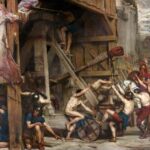Roman camp at Novae in today’s Bulgaria was inhabited by more legionaries than previously thought. In addition, it also turned out that the place was not abandoned due to the Huns’ invasion in the 5th century. This is evidenced by the rich houses discovered from that period.
The research is carried out by the mission of the Antiquity of Southeastern Europe Research Center of the University of Warsaw under the supervision of prof. Piotr Dyczek. As the scientist explains, the monumental structure from the 5th century is a real puzzle for the team. So far, archaeologists have uncovered over 1000 square meters of its surface.
“It was a very rich building, as evidenced by the portico, as well as the objects that we discover inside,” says Prof. Dyczek.
According to the scientist, the building could serve as the seat of municipal authorities. Prof. Dyczek explains why so far no structures from the 5th century have been found. “It was believed that before the influx of barbarians, the city was abandoned, so no traces of structures from that period were searched for. Meanwhile, it was completely different – buildings from the 5th century were probably demolished when the nearby city of Svishtov was built in the Middle Ages. Local residents treated the ancient city as a quarry” – says the researcher.
This year, another mystery was solved. Later written sources indicated that the first elected cohort of the 8th August Legion to be stationed at Novae consisted of twice the number of legionaries.
“During the excavations, we obtained confirmation that not only in the 1st cohort of the 8th Augustus legion there was a double number of soldiers, but also in the case of the legion stationed later – in the 1st Italian – the situation repeated. Only that in the latter case, the double barracks were no longer built of wood., but made of stones. The structures were over 80 meters long, so they were monumental “- says Prof. Dyczek.
There are not much more than foundations left of the buildings, which is why scientists were pleased this year with an interesting find in the form of a channel made of roof tiles – knots – related to the functioning of these structures.
Another large building adjoined the stone barracks, which archaeologists began to discover last year. Scientists speculate that it was probably the home of the legion’s most senior centurion. The interiors testify to the old luxuries – the floor was originally lined with marble slabs. A rainwater pool (so-called impluvium) was also discovered, which is the central, unroofed part of the house, known as the atrium. The walls of the villa were covered with stuccoes and paintings.






